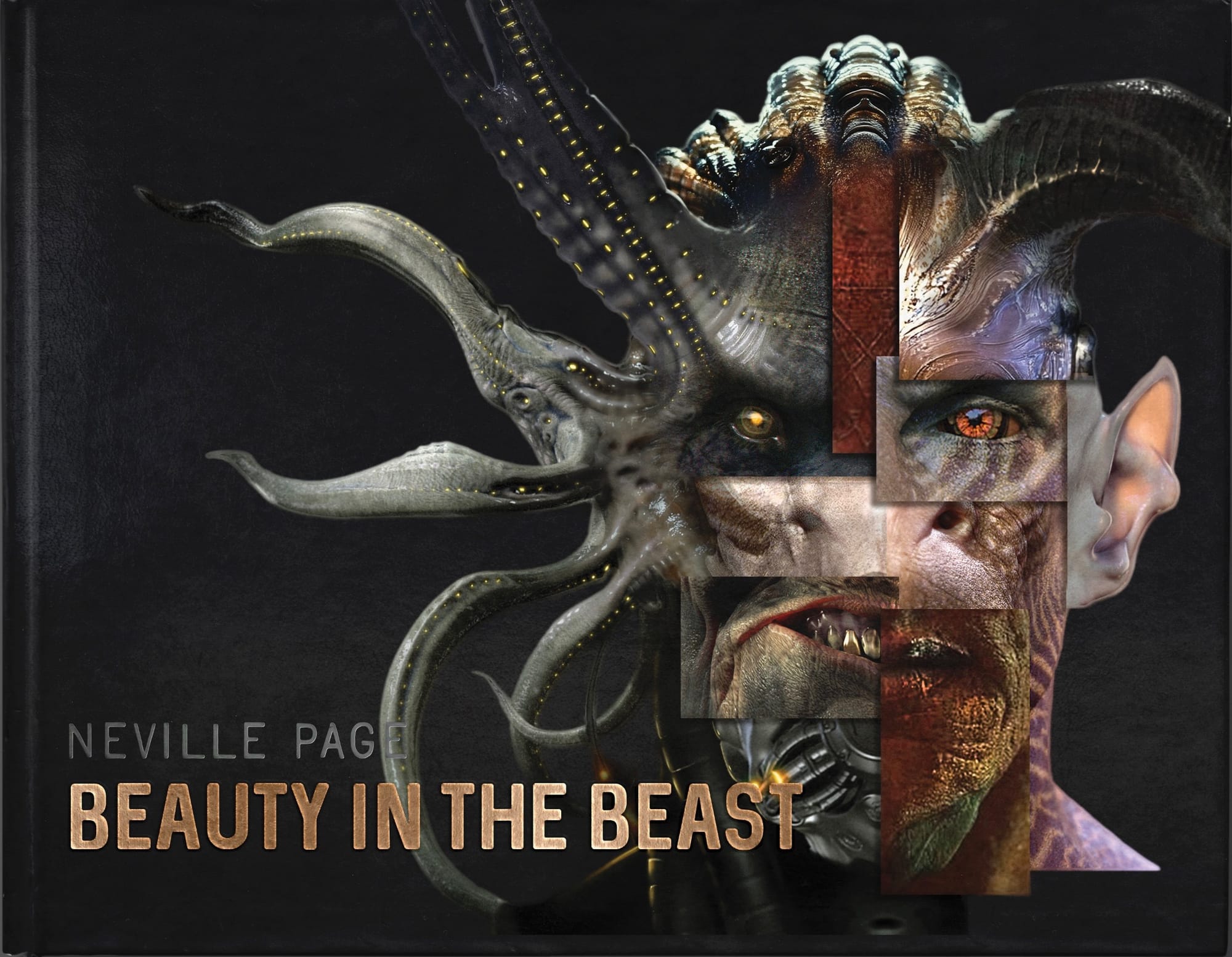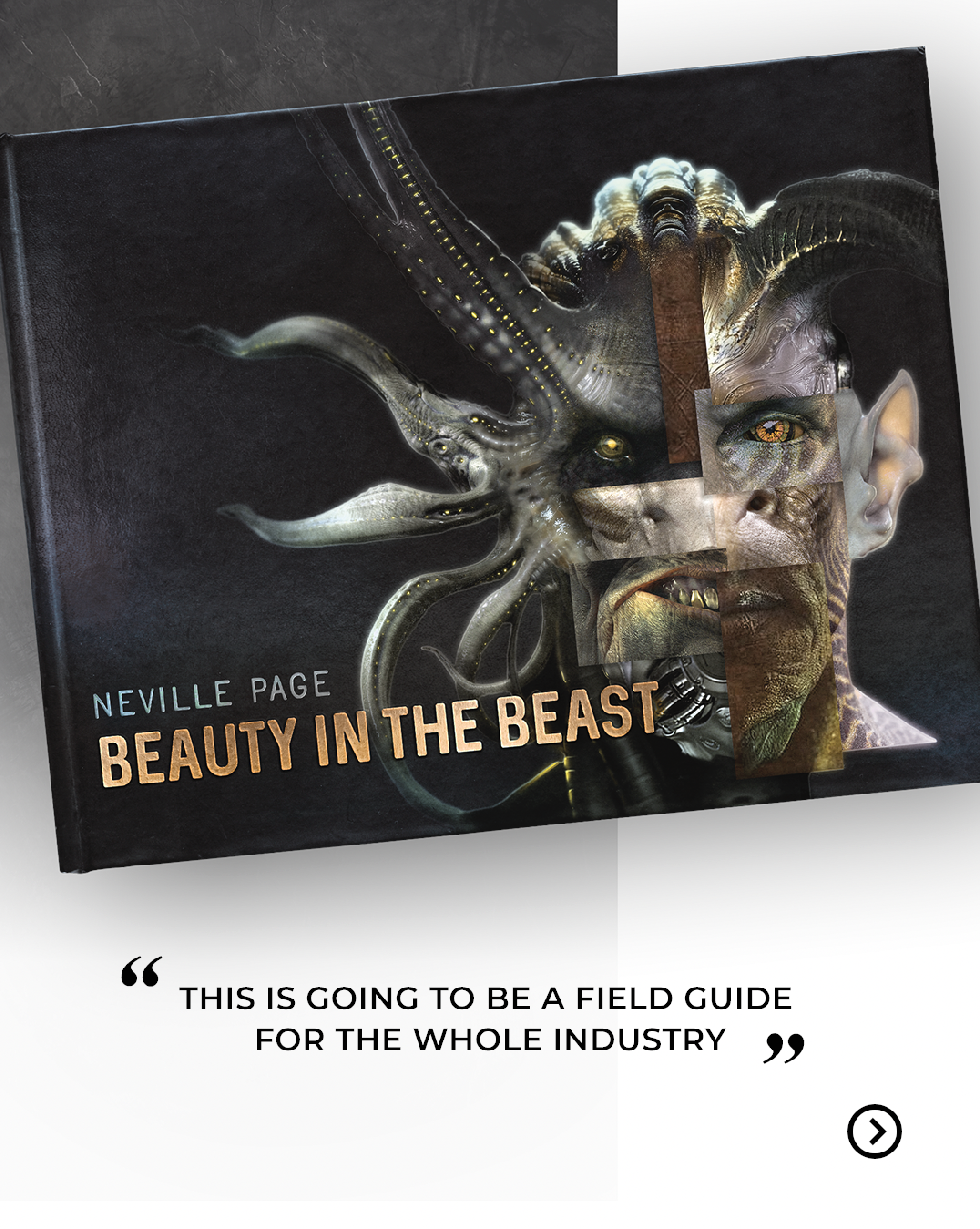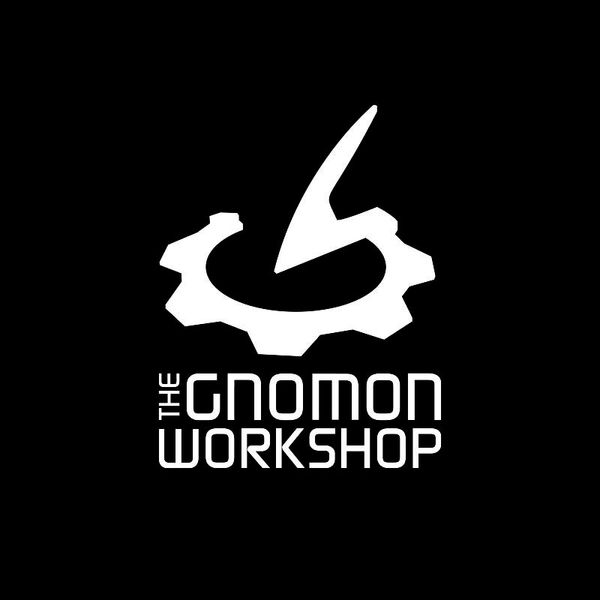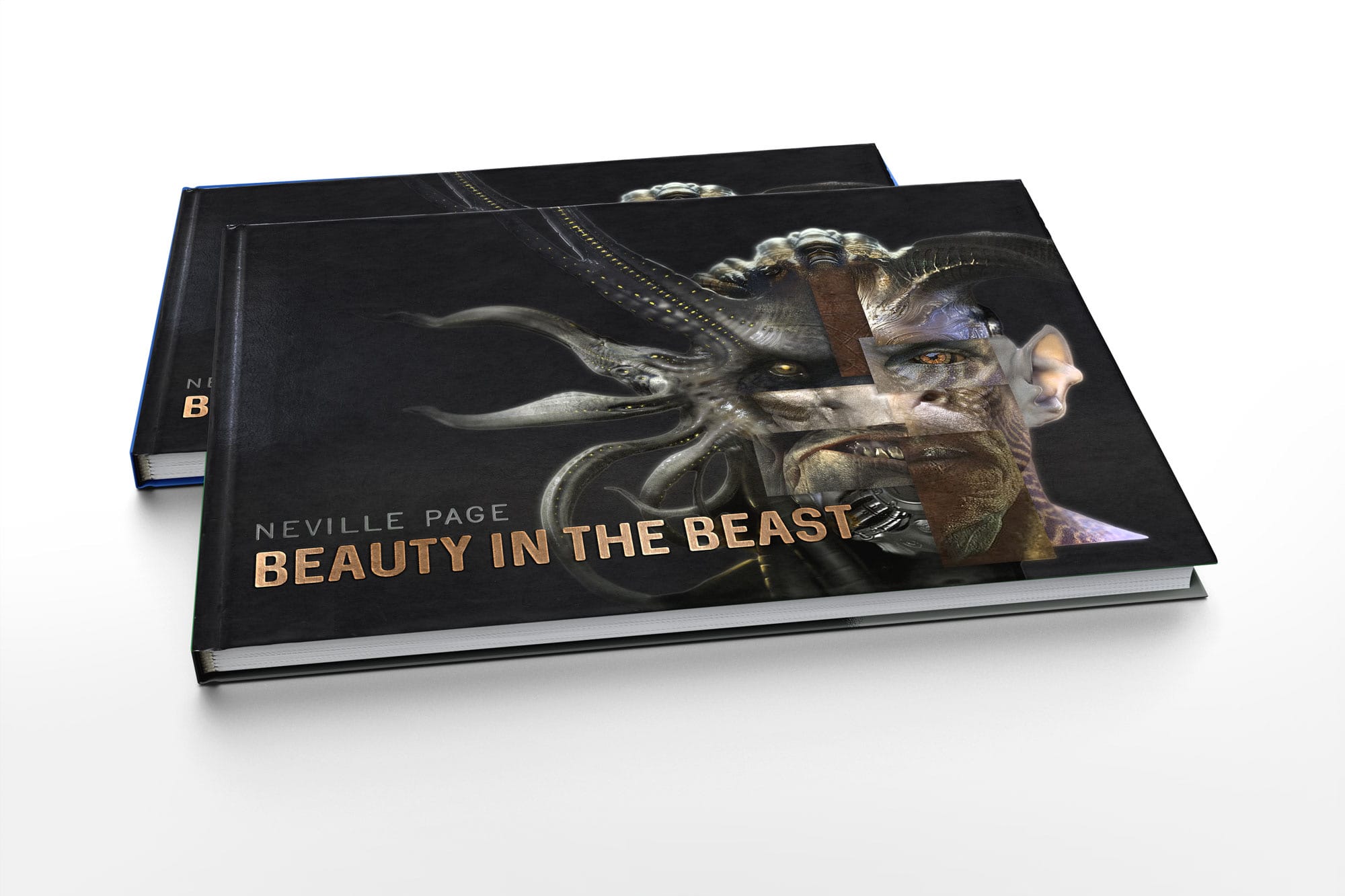In Part 1 of our conversation, concept designer Neville Page walked us through his Virtual Makeup Design workshops and his decades-long commitment to education, technical growth, and honest design.
In this second part, we shift focus to his upcoming book, Beauty in the Beast — a manifesto for navigating the emotional, philosophical, and practical challenges of working in entertainment.
The Gnomon Workshop: Let’s discuss your upcoming book, Beauty in the Beast. The book very much explores these themes of mindset, collaboration, and resilience. Do you think that, to thrive in this industry today, creatives need both the technical craft and the mindset to navigate the emotional and practical realities of the work and industry today?
Neville Page: Absolutely. Without question. It’s a bit like being in school, whether you’re studying medicine, business, or art. You’re usually taught the craft — how to be a good doctor, chef, or accountant — but you’re not often taught the realities of those careers. You occasionally get that one instructor who comes in and tells it like it is, and by the end of the day, you’re questioning your life choices! Is it really that hard to be a chef? That hard to be a designer?
And honestly, most work is hard. I’ve had a lot of different jobs in my life, and I can barely think of one that felt like a cakewalk. Even working at Del Taco, making burritos, burgers, and fries, was really hard work. There are even moments, working as a designer on a film, where I think: This doesn’t even compare to how tough that job was.
Whatever you’re doing, you still want to enjoy the creative part — the reason you got into it in the first place — but you also have to function within a team, with other people. Very few jobs exist in total isolation. So, part of what I try to share in the book is based on my own experiences: Navigating work environments, understanding people, and maintaining your creativity and self-worth.
The book isn’t a biography, exactly. But I do share personal stories and lessons in the hope that, if something resonates, the reader can see how it might apply to their journey. There are some universal themes that apply across all creative disciplines — whether you’re into poetry, painting, performance, or design. Everyone knows what burnout feels like.
I’ve been teaching for 20 years and working in the industry for nearly 30, so I’ve seen burnout firsthand — not just in myself, but in others as well. And being a bit of an empath, I try to really listen to what people are going through. If asked, I share what I’ve learned. That’s where I think the book's real value lies. YouTube is packed with tutorials on how to draw or design a creature. But there’s far less out there that talks about burnout, impostor syndrome, self-doubt, and how to move through those experiences.

“Some people are sensitive to any kind of criticism. And if you’re working professionally, especially for money, you have to be able to hear feedback, at the very least, so you don’t get fired. But more importantly, so you don’t come out of it feeling depleted or broken.” Neville Page
TGW: Do you feel like those emotional challenges — burnout, self-doubt, imposter syndrome — are talked about enough in creative education? Or is that still a gap you’re hoping this book can help fill?
NP: I’m not projecting my experience onto anyone. I just hope people read the book as my story, my take on how I overcame things. I don’t want to tell people how to be—I want to offer a perspective. For example, how do you critique your own work, or someone else’s? And how do you receive criticism in a way that keeps you balanced?
Some people are sensitive to any kind of criticism. And if you’re working professionally, especially for money, you have to be able to hear feedback, at the very least, so you don’t get fired. But more importantly, so you don’t come out of it feeling depleted or broken.
There’s a part of the book where I share little “demos” — not literal drawing demos, but things I’ve found helpful. Like, if you’re stuck in a rut: Put the pencil down, go outside, take a deep breath, listen to some music. That might work for you, or not — but I offer it as a seed of an idea. In the same way, I might show someone how to draw a cube: Draw a horizon line, two vanishing points, and connect the lines. You give someone some rules — some structure — and that can lead to creative freedom. That same idea applies to mindset.
And then there’s this romantic idea of what it means to be an artist. We’ve all seen it in movies — the grungy loft in Paris, the struggling painter, freezing in winter with a space heater and a threadbare sweater, chain-smoking. It’s cinematic. But in real life, that sucks. People want to be warm. They want to eat. They want to feel safe. Movies romanticize suffering, and we start believing that’s what an artist should be. Over time, I realized: That’s not what I want. I’m not saying I was lied to, but I did buy into something that doesn’t actually serve me. And I think a lot of people go through that.
What’s fascinating to me now is how deeply our design practice connects to our personal lives. The way I design creatures, the way I approach a “beast” — it mirrors how I try to understand and interact with other people. That’s why the book is called Beauty in the Beast. It’s not just about showing that a crab or grotesque creature can be beautiful, though that’s part of it. It’s about confronting the real beasts in our lives.
The beast could be Hollywood. It could be your inner critic. It could be burnout, insecurity, a toxic relationship, or self-doubt. But when you stop and really observe what scares you, when you remove the ignorance and fill it with knowledge, you realize that the beast isn’t so scary anymore. You see the beauty in it.
If someone finishes this book with a little more empathy — for themselves, for others, for the unknown — then I’ve succeeded. If they also learn how to draw a cube or design a creature, great. But you can find that anywhere. What I’m trying to offer is something more profound. And I want to do it with humor, elegance, and grace.
After 30 years in the industry and a lifetime of consuming entertainment, I’ve reached a point where I just don’t want to create anything that doesn’t have value. If I’m going to write or work on a movie, I want it to have some meaning — something that contributes to humanity in a positive way. That’s not me being anti-horror or anti-entertainment. I love action, violence, sex, drugs, rock and roll — bring it on. But I believe we can craft those stories in a way that’s more emotionally nutritious. There’s room for work that’s exciting and healthy. Stuff that leaves you saying, “That sword fight was awesome,” but also feeling something deeper. That’s what this book is about.
“Whether you’re designing a car, a ballet, a dish, or a creature, you need to know who you’re trying to reach. And if you’re trying to say something meaningful — if you’re trying to message something deeper — then you’re either targeting a new audience or aiming for a broader one. But that comes with the risk of watering down your message.” Neville Page
TGW: What’s the one message you hope really stays with readers after they’ve put the book down? I know you touched on it a little already, but is there something you’d say really sums it up?
NP: I want someone to come away from this book not just satisfied, but surprised — like they got dessert, and it turned out to be good for them. You know, no calories, no guilt, but still incredibly satisfying. A dopamine hit that also happens to nourish you. I know that sounds odd — food analogies come up a lot for me, even I find it strange! But it works as a metaphor.
One of my core philosophies, which I explore in the book, is that you have to understand your audience. Whether you’re designing a car, a ballet, a dish, or a creature, you need to know who you’re trying to reach. And if you’re trying to say something meaningful — if you’re trying to message something deeper — then you’re either targeting a new audience or aiming for a broader one. But that comes with the risk of watering down your message.
So, I use the Big Mac as an example. Sure, not everyone loves Big Macs, but the reason McDonald’s is so successful isn’t just marketing; it’s because the flavor is designed to be universally satisfying. It’s salty, fatty, flavorful (assuming you’re not vegan, of course). Millions of people respond to that.
Now imagine this: You make something that looks, smells, and tastes like a Big Mac. People come in with that expectation, and they get exactly what they thought they were ordering. But then, after they’ve eaten it, you tell them: “By the way, the buns were made locally, the patty’s actually vegan, the lettuce was sustainably grown nearby, and it’s a third of the calories of what you’d expect.” That is what I want this book to be.
You can only achieve that if you put in the effort on both sides. You have to deliver the experience people came for, and you have to make it genuinely good for them. Otherwise, you’re just creating French cuisine; personal, beautiful, but limited in reach. You won’t connect with a large audience.
So yes, the book will give you what it promises. But my hope is that there are layers to appreciate. One person might connect with the chapter on self-deprecation. Someone else might not relate to that at all, but they’ll find value in the sections on creative block or impostor syndrome.
I’m not claiming the book has all the answers — it’s just my experience. But I can say, with some confidence, it’s a lot more than just a creature portfolio or a how-to-draw guide.

TGW: We’ve talked a lot about mindset already — and I know you even have a chapter about it in the book — but I wanted to end on a forward-looking note. As you mentioned earlier, the industry is in a strange place right now, and AI is a hot topic. What kind of mindset shift do you think the next generation of artists will need as they continue creating in this new environment?
NP: That’s the most challenging question to answer, and it’s one I’m actively trying to explore in the book. I’ve also tried to answer it on panels and in public discussions. I can speak to it not in the abstract, but from personal experience, because I’m in it. I’m not retired and speculating from the sidelines. I’m dealing with this shift right now.
And the first thing I’d say is: We need to examine what we actually feel threatened by.
Most questions about AI come from a place of fear. It’s not like someone’s saying, “Hey, now that we’ve solved shelter and food, what do you think comes next?” No — it’s more like, “This thing could take everything away from you.” So, the first vital step is understanding what exactly feels threatening. I see many people reacting to AI without having the right information. I won’t even say “enough” information, because even I don’t have that, but I try to have appropriate information.
Just like anything in life, you have to vet your sources. And right now, we’ve entered a kind of cultural paradigm shift into ignorance. People read a headline and run with it as if it were gospel. That’s all they need to know. And this is slightly off-topic, but bear with me: I’ve written a script called The Coalescence. It’s a World War I sci-fi drama that, like the Big Mac analogy, ticks the boxes for entertainment. But beneath that, it’s deeply philosophical. It explores how we choose a belief system — such as nationalism, religion, or leadership — and how we live by that choice.
While writing it, I had one of those moments where the idea starts simple — like, “I’m going to spin this pottery wheel and make a teapot” — but then you realize: Where does the spout go? How do you keep the handle cool? How do you pour without the lid falling off? Suddenly, it’s not just spinning a pot anymore, it’s designing something functional. That’s what writing this script became. And it made me think a lot about indoctrination and how we often inherit ideas without questioning them.
Religion is a great example. I’m not criticizing any particular belief system here—what I’m saying is, many people are born into it. You’re born into a family, a state, a country. It’s logistical. You didn’t choose to be in that gang or on that team; your mom just happened to give birth to you in that zip code. That doesn’t make it inherently wrong or right, but what happens next matters: Do you ever question it?
A lot of the fear around AI comes from that same place — an unexamined fear. “I’ve learned my tools. I know how to draw. I know how to sculpt. And now this thing is coming to take my job.” But we often don’t stop to ask: What is it really? What is it actually doing?
I’ve played with AI tools. I did it because I wanted to know what it could do to me. And I proved to myself, very quickly, that a version of “Neville” using AI could outdo the current version of me without it. And that was terrifying. I had to face the question: Do I try to beat AI…or do I figure out how to work with it?
I still don’t know the answer. But what I do know is this: Ignoring it won’t help. And embracing it blindly without understanding it is just as dangerous.
AI is going to take jobs. It’s going to change how hiring works. That’s happening whether we like it or not. We can complain all we want, but people in positions of power — those with the money — will still decide how to scale back departments like ours. We can’t stop that. But we can educate ourselves. We must educate ourselves.
Putting an anti-AI logo online and saying, “If you use AI, you’re dead to me” — that’s not helpful. That’s the kind of reactionary behavior that cancel culture thrives on. Instead, we need to learn together. We might conclude AI is a net negative. Or we might find some value in it. But until we’re properly informed, we’re just guessing and reacting from fear.
If your chosen “religion” is Photoshop, and a new tool comes along that challenges your sense of mastery, you’re naturally going to resist it. But I say: Be open. This goes back to the core idea behind Beauty in the Beast. When you teach a kid not to step on an ant, not because it’s sacred or divine, but because it’s a living thing with a task, you’re planting the seed of empathy. And that seed can grow into a way of seeing the world. It starts with an ant and extends to people, to ideas, to the unknown.
If we can approach AI with that kind of awareness — intellectually and ethically — we may be able to guide it, shape it, and even build a community with it.
I’m still deeply concerned, of course. About the dilution of artistic voices. About the decline in critical, personal thinking. About how we measure creativity moving forward. But the reality is: AI is a hammer. It’s here. We need to figure out how to wield it.
As for Beauty in the Beast and writing about AI in a book? That’s a real challenge. The technology is changing so quickly. If the Kickstarter is funded, the book goes to print, and it comes back six months later, we’ll already be a year out from today. And with AI, a week can make something obsolete.
So, what I’ve decided is that the AI chapter won’t be static. It’ll be a QR code that links to a living, ongoing conversation where I can share my latest thoughts and observations as things evolve. Not just the facts — because those change — but my personal reflections on how AI is shaping our world and our industry.
Some parts of the book will always be universal. But others, like AI, will need to stay fluid. And I want to respect that by giving readers a way to keep that conversation going.
Because this industry — this community — is all about conversation, collaboration, and working together.
Neville’s new workshops, Virtual Makeup Design: Volume 1 and Volume 2, are now available at Gnomon Workshop. Whether you’re looking to level up your sculpting, rendering, or presentation skills, they offer a detailed look at the professional techniques behind production-ready design.
To go deeper into the mindset, resilience, and creative philosophy that have shaped Neville’s career, you can support his upcoming book, Beauty in the Beast, on Kickstarter. It’s more than a collection of creatures: it’s a manifesto for staying curious, evolving with the times, and creating with intention in a changing world.
→ Watch Neville’s workshops at gnomonworkshop.com
→ Support Neville’s book, Beauty in the Beast, on Kickstarter

The Gnomon Workshop
The Gnomon Workshop, the industry leader in professional training for artists in the entertainment industry.
follow me :




Related News
Beauty, Beasts & Better Pipelines: Neville Page on Digital Design & Practical Makeup
May 07, 2025
Capturing Assets & Environments for Call of Duty: An Interview with Gui Rambelli
Feb 10, 2025
Balancing Elegance with Aggression: An Interview with Chris Beatty
Nov 21, 2024